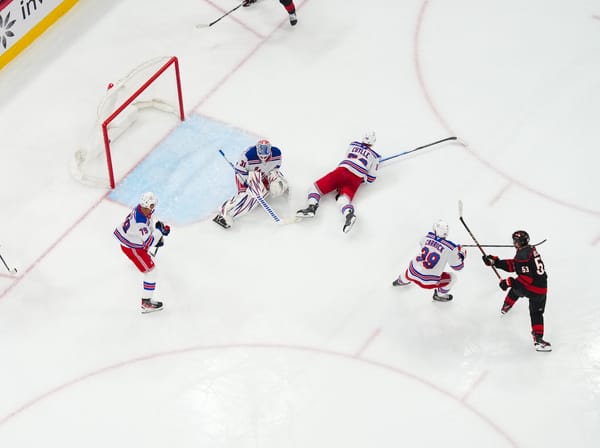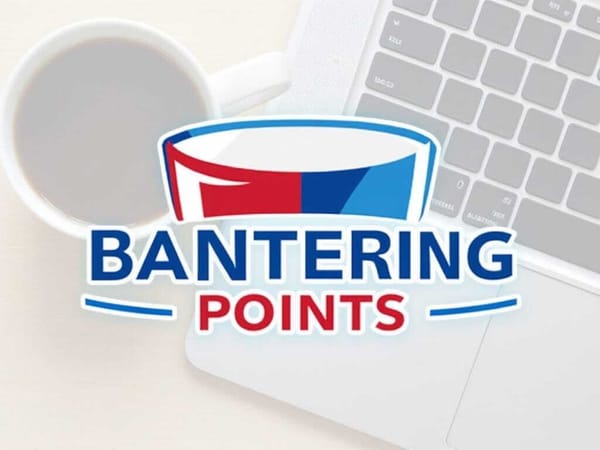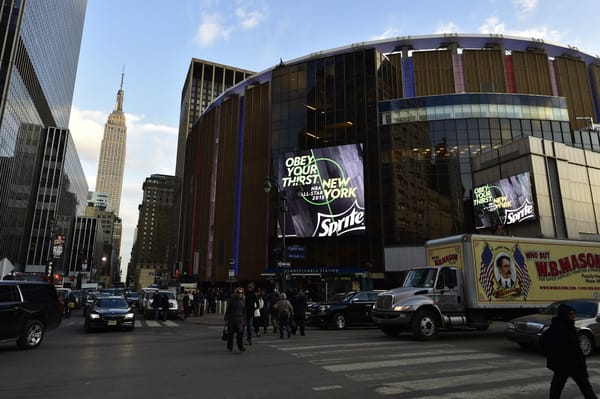What Have We Learned? A Look at Games 7-9
Another week later and the New York Rangers have made some progress, but it’s still not enough. At this point last week, they were second-to-last in the league standings. Right now, they’re in fifth-to-last place as this week’s 1-0-2 record helped them earn four more points. While that’s progress from last week, there’s still a lot to be concerned about within this lineup, and a lot to learn moving forward.
The Rangers faced the Pittsburgh Penguins, New York Islanders, and Nashville Predators this week. In two of those three games, the Rangers didn’t get off to the best start – allowing a goal 43 seconds in against the Penguins and 2:40 in versus the Islanders. Their starts this year haven’t been ideal, and while they didn’t allowed a goal in the opening minutes on Saturday against the Predators, one game doesn’t answer whether or not they won’t continue this trend of finding themselves at a disadvantage early in their upcoming games.
Against both the Penguins and the Islanders though, the team was able to bounce back – enough to reach overtime. On Tuesday, the Rangers actually took the lead twice. However, in both instances in which they actually had the lead, they weren’t able to maintain it. And in overtime, it was a Ryan McDonagh giveaway that cost them the game.
On Thursday, the Rangers never held the lead – rather they battled back from a 3-1 deficit in the third-period to force overtime. Ultimately, they lost in a shootout, but that isn’t exactly indicative of this team’s abilities.
Speaking of that Ryan McDonagh giveaway on Tuesday, it was well, really bad. It was un-McDonagh like. The thing is, we’ve always held McDonagh to a high standard because we’ve seen just how skilled he is – and he managed to show that high-caliber play with an anchor of a partner during Dan Girardi’s decline. This season, we’ve been anticipating McDonagh Unchained, and we haven’t quite seen it yet. It was assumed that he would play alongside Kevin Shattenkirk and show the rest of the NHL his stellar play, but that hasn’t happened yet. He hasn’t played with Shattenkirk enough to develop chemistry – or really any defenseman, since there hasn’t been much consistency in the defensive pairs – and that may have subsequently caused his slow start.
Through the Rangers’ first 9-games, McDonagh’s led the team in 5v5 ice time (148.42 minutes). And despite this less than ideal start, he still leads the team with a 54.71 Corsi for percentage and is plus-11.26 relative to his teammates. There’s no reason to panic about McDonagh’s game yet, players are bound to make mistakes – what’s important is that they learn from those mistakes and don’t repeat them in the future.
Skating alongside McDonagh for much of this week, except for Saturday when he only played 5:20 in all situations (4:12 of which came on the power play), was Tony DeAngelo. When DeAngelo’s made mistakes in his own zone, like against the Toronto Maple Leafs, he’s paid for it – with scarce ice time the following game against Montreal, and a seat in the press box the next two after that. Since then, DeAngelo’s earned his ice time. He’s accumulated the second highest Corsi for percentage on this team of 54.14 ( plus-8.72 relative), although his expected goals for percentage isn’t as favorable at 44.86 (minus-4.09 relative). While DeAngelo still has to refine his game in his own zone, that requires ice time and coaching to help progress his development – not stapling him to the bench for replacements with less upside.
DeAngelo’s game on Tuesday and Thursday didn’t merit a demotion on Saturday. But on Saturday, that demotion came when 11 forwards and seven defensemen were deployed. That lineup strategy is particularly questionable when the seventh defensemen is barely utilized. Demoting DeAngelo to such little ice time made little sense, especially since his missteps so far this season haven’t been nearly as damaging as the those of the defensemen who have replaced him.
According to head coach Alain Vigneault, the reasoning behind DeAngelo’s usage in lineup on Saturday was his right-handed shot on the power play. His power play presence definitely has been notable and has elevated the struggling second unit, but that still doesn’t explain why he received minimal 5v5 ice time.
Making DeAngelo the seventh defenseman wasn’t the only change on Saturday. Brendan Smith was moved to the first pair alongside McDonagh, while Nick Holden was paired with Brady Skjei. The pair of Marc Staal and Kevin Shattenkirk remained, and while it isn’t exactly ideal to have their biggest free agent acquisition of the 2017 offseason on the third pair, he still received higher ice times than most defensemen this week. And while it’s clear Staal isn’t a top defenseman anymore, his play has been fine enough for a third pair role to not merit criticism.
Holden’s play on the other hand, was dismal enough to merit criticism on Saturday. Somehow, he finished with 16:36 minutes in all situations, which was more than Skjei, Smith, and obviously DeAngelo, and saw more time on the penalty kill (5:29) than any other defenseman.
The Rangers led their opponents in all-situation and 5v5 shot attempts on Tuesday and Thursday. On Saturday, as they were out attempted 62-38 in all situations and 43-23 at 5v5.
Holden, who had a minus-12 Corsi differential at 5v5 and finished the game with a minus-15.48 relative Corsi for percentage, only further proved why he’s a defensive liability that shouldn’t have a consistent role in this lineup this year.
To make matters worse and show just how much this coaching staff hasn’t learned from their mistakes last season, postseason, or even early this season, Holden was deployed in the final moments of a one-goal game when the Rangers were trying to maintain their lead – final moments that were so challenging, that even Henrik Lundqvist expressed his relief when Jimmy Vesey scored an empty-net goal to give them some breathing room.
Shifting to offense, there have been some positive and negative takeaways. Let’s start with a player that’s a mix of both – Pavel Buchnevich. Buchnevich’s play has been impressive to start the season; his vision, puck moving abilities, and lethal shot have all been on display already. Here’s the negative: he’s somehow been demoted to the fourth line, despite how well he played with Chris Kreider and Mika Zibanejad on the first line. What isn’t clear though, is if this is because of his performance, or if this is an attempt to ignite the play of fellow fourth-liner Michael Grabner.
Grabner’s 40-point season last year was a welcome surprise – but a surprise nonetheless. It didn’t accurately reflect the player that’s on this team; he’s a perfectly capable two-way player, one that has impressive speed and finds himself with breakaways opportunities often, but 27-goals and an inflated shooting percentage shouldn’t be expected of him again. So it that was the intention of shifting Buchnevich to the fourth line, it’s a short-sighted one that makes this team less dangerous on offense.
But if this isn’t a punishment, then why has he seen some of the fewest minutes on this team?
If this is in fact a demotion, it’s definitely not a logical one. Focusing on 5v5, since he rightfully still has a place on the top power play unit, Buchnevich has the fourth highest Corsi for percentage on this team of 51.98; the only forward he trails is Zibanejad. Individually, his Corsi for per 60 is 16.7, which is the second best on the team to Rick Nash. Also, he has the best expected goals for percentage on this team of 58.76 (plus-14.37 relative).
A forward that’s received a lot of ice time and is playing a bigger role than expected is David Desharnais. It was assumed that Desharnais would be a bottom-six center, behind Zibanejad and Kevin Hayes. This week, Desharnais has been utilized as the team’s second line center between Kreider and J.T. Miller. This promotion, along with the place team’s second power play unit, has sparked some questions as it keeps Hayes on the third-line – someone, who according to Vigneault, was competing with Zibanejad for the role of first line center.
It’s not to say that the combination of Kreider, Desharnais, and Miller hasn’t had some success on the surface. While this combination has scored, and Desharnais has earned four points in all situations over the last three games, it doesn’t mean this is the best combination available or that Desharnais is necessarily in the right role. Not only has this line combination accumulated a low 35.85 Corsi for percentage and 36.26 expected goals for percentage in their 29.07 minutes of 5v5, their PDO of 118.18 is the highest of the Rangers’ line combinations – so it’s not clear yet if their “success” is sustainable.
And, for whatever it’s worth, if the idea is to boost Grabner’s production, he did manage to score while playing with Desharnais on Tuesday – so maybe that’s a combination that should be revisited, just in the bottom-six.
Below Desharnais in the lineup in Hayes on the third line, whose been playing with Jesper Fast and Jimmy Vesey. So far this season, Hayes has been playing really well. On Saturday against the Predators, Hayes put that skill on display on both sides of the ice. The more he continues to play at this level, and the more this team craves 5v5 offense, the more questionable it becomes that he isn’t in a more offensive role. Hayes has much more offensive upside than someone like Desharnais that the Rangers should be looking to unlock, but instead, he’s asked to emulate a defensive game that he isn’t as suited for.
Lastly, the Rangers wouldn’t have been able to finish this week with four points if it wasn’t for Lundqvist between the pipes. Although he did allow some goals that he’d probably like to have back, it doesn’t take away from how he kept these games within reach for his team.
Saturday was particularly impressive for Lundqvist, as he was the primary reason the Rangers were able to finally earn their second win of the season. And while he allowed two goals, both were on high-danger shots, the Rangers were so lucky he didn’t allow more based on how they played.
Charts for Predators at Rangers are up at https://t.co/TL4gHnM2R9
— Micah Blake McCurdy (@IneffectiveMath) October 21, 2017
Safe to give a lot of the credit here to Lundqvist. pic.twitter.com/7UQWqh2Buu
Lundqvist hasn’t been the reason for the Rangers struggles this season and he’s continued to be their backbone when they’re needed (and they’ve needed it a lot this season already). There has been far too much talk about Lundqvist’s age this offseason – it’s no secret he’s aging, but he’s capable of defying aging curves. However, at 35-years-old, they shouldn’t expect Lundqvist to carry them every game, and he shouldn’t have to.
The defense was renovated so Lundqvist wouldn’t have to carry them moving forward. It’s been only 9-games, but it’s an unstable trend from the Rangers that’s been seen throughout Lundqvist’s career. Just because they have a generational talent in net, doesn’t mean they should rely on him for every win. They have to support their goaltender, and so far this season they haven’t done it enough.
Finishing another week and collecting four points in three games on the surface doesn’t look to concerning, but for the Rangers it is. It took until the ninth game of the season for them to earn their second win. Two in-division games were lost this week, both of which the Rangers had home-ice advantage in.
Before Saturday, it had been six games since their last win, but still it doesn’t look like much has been learned since.
Had it not been for Lundqvist, the inexplicable lineup decisions on Saturday could have cost them another game. Their forward depth is still weak, and deploying 11 forwards because the 12th and 13th forwards (Adam Cracknell and Paul Carey) aren’t strong enough isn’t a sufficient option moving forward. The onus is on management to improve this group and to find a player the coach is willing to utilize accordingly. But the onus is also on the coach to find viable combinations with the group he has – ones that will actually bring his team to success, rather than relying on veterans he’s more familiar with.
There’s still a lot of hockey to play and their end results from this week are a step in the right direction, but their on-ice play still needs to improve if this team is going to have sustainable success moving forward.
*Data is at 5v5 via Corsica.hockey




